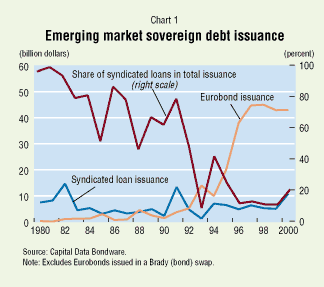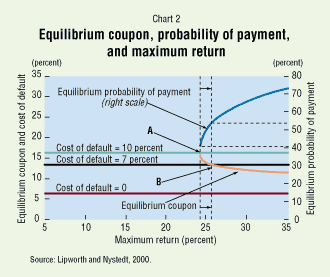 About F&D Subscribe Back Issues Write Us Copyright Information |
Crisis Resolution and Private Sector Adaptation Gabrielle Lipworth and Jens Nystedt The approach [to dealing with developing countries' debt crises] was balanced, in that all parties accepted a need for burden sharing within a concerted effort. It was case-by-case, in recognition of the fact that each of the restructuring countries had its own particular circumstances. And it also had to be flexible, given the many political and economic variables at work internationally and within each restructuring country.—William R. Rhodes, Citibank (1989) Before the debt crises of the 1980s, medium-term loans from large syndicates of commercial banks to developing country governments and public sector organizations were the dominant form of international capital flows. An important part of the mechanism that the official sector used to deal with these crises involved the concerted rollover and subsequent restructuring and write-down (in present-value terms) of syndicated bank loans. International bonds issued by the affected governments generally escaped restructuring because the amounts were small and these instruments, held by widely diversified creditors, were difficult to restructure. After the crises occurred, credit markets adapted to changed realities. Medium-term syndicated bank loans to developing country governments largely disappeared in the 1990s (see Chart 1). International banks shifted to extending interbank loans for much shorter periods. International borrowing by governments was done predominantly through Eurobond issues. These shifts in international credit flows posed new challenges when the financial crises of the 1990s had to be resolved. Lenders to emerging markets were either thousands of individual bondholders, whose actions were difficult to coordinate, or international banks, with mainly short-term loans outstanding, that could easily "cut and run" in a crisis. The shift to Eurobonds was partly motivated by the objective of increasing the cost of default for debtors, because creditors believed that this particular debt instrument would be very hard and time consuming to restructure and that any restructuring would be likely to lead to large output losses for the defaulting debtor. These output losses would encourage debtors to do their utmost to service their Eurobonds. The growth in interbank lending was explained partly by international banks' shifting to a debt instrument that would have a higher recovery value (the total of payments expected following default) if a default loomed, because the instrument's short maturity would increase the probability that the creditor would be able to spot problems before a default occurred and, hence, manage to call the loan just before the crisis erupted. Moreover, in the eyes of the international banks, making loans for only short maturities made it less likely that they would be asked to participate in crisis resolution, as had happened in the late 1980s and early 1990s.

Given the widespread use of these new debt instruments, however, it was inevitable that the official community (including governments and multilateral organizations) would have to deal with restructuring them when the next string of crises came along. Mechanisms for private sector involvement in resolving debt crises also therefore needed to be adapted to the new realities of cross-border lending to emerging markets during the 1990s. An interesting issue to explore is whether the factors that brought about the shift in lending instruments in the early 1990s will cause a similar shift following the most recent string of financial crises. Moral hazard Creditor moral hazard may exist when the private sector's lending decisions are biased by expectations that the official community will provide assistance if a debtor government enters a crisis. Some have argued that while the official community has focused on limiting creditor moral hazard (other objectives of the official community have included reducing the size of assistance packages and ensuring the stability of the international financial system), private sector creditors have focused on finding debt instruments that mitigate debtor moral hazard. Debtor moral hazard may exist where there is a risk that if default on sovereign (government) debt is made less costly, more debtors will choose to default even though they may still be able to service their debts. The risk that a debtor will seek to avoid payment of debt is a key concern of any creditor and must be assessed before the creditor decides whether to extend new financing. Obviously, if a debtor were deemed unwilling to repay a loan he had requested, that loan would not be made. Many official community initiatives to enhance private sector involvement in crisis resolution were, and still are, seen by private sector creditors as weakening their bargaining positions vis-à-vis debtors and reducing the latter's cost of default. This is especially true for lending to emerging market governments, which frequently enjoy immunity, can hide their assets, and are aware that no well-defined bankruptcy procedure is available to the creditor. In the absence of a bankruptcy court, a creditor has to find other means of ensuring that a default on a loan is due to inability to pay and not unwillingness to pay (as would be demonstrated by a "strategic default"). Costs of default and recovery values How can a creditor increase the cost of default for a debtor government? Can this cost be imposed only when the debtor decides to default strategically? The actual costs of default for a debtor include the tarnishing of its reputation, losing market access to both trade and long-term financing, being a target of costly litigation, and experiencing output losses while in default owing to a lack of foreign capital for investments. Unfortunately, it is very hard, both in theory and in practice, for a creditor to know why a particular debtor has defaulted. The best the creditor can do, because it cannot make the cost of default conditional, is to make sure the debtor has to pay a cost irrespective of the type of default. But this is an inefficient outcome, and it would be better for both the debtor and the creditor if it could be established why a default had occurred. It has been argued that following a default, irrespective of type, it would always be in a creditor's interest to avoid imposing a cost of default after the fact, because doing so would reduce the recovery value. Both creditors and debtors have understood that it was not credible to impose a cost of default after the fact and that lending would not occur if there were no disciplining device available to the creditor. They have therefore sought to include an alternative device in lending instruments that would impose a default cost that could not be easily reduced by either the creditor or the debtor. Both therefore have structured lending/borrowing instruments so that they would be very hard to restructure. Michael Dooley (2000), for example, has argued that the difficulty of renegotiating Eurobonds was by no means an accident—indeed, it was one of the few ways creditors and debtors could find a solution to debtor moral hazard. Implications for emerging market governments How would lending flows to emerging market governments be affected, and which debtor governments would be most affected by a reduction in the cost of default? The creditor is likely to adapt to changes it perceives in the cost of default and also to any changes affecting its estimate of what recovery value to expect in case of default. Arguably, the cost of default for the debtor and the recovery value for the creditor are only two variables that help to determine the value of a particular debt contract. For a creditor, however, a reduction in both the cost of default and the recovery value would reduce the value of already outstanding debt. For new lending, a creditor might want to adjust to such a reduction by charging a higher interest rate up front, reducing the amount of new financing available, or shifting to new lending instruments that have higher costs of default or recovery values than the lending instruments used previously. Using the simple theoretical model we developed and assigning some arbitrary values purely for illustrative purposes (see Lipworth and Nystedt, 2000), reducing the cost of default can have three effects on lending to emerging market governments (see Chart 2). Low-quality and high-quality debtors are distinguished by determining what their maximum returns (on the investments made with the borrowed funds) are. The higher the potential return, the higher is the probability of repayment, because it is increasingly likely that the return will exceed the interest rate charged and the debtor will be able to repay the original loan.

The implications of the cost of default for the official community's policy on private sector involvement are therefore quite clear. On the one hand, if the cost of default is too high before the official community intervenes, it will be welfare enhancing to reduce the cost of default. On the other hand, if the cost of default is a binding constraint, any initiative that reduces the cost of default will encourage a shift in equilibrium (for example, from point A to point B in Chart 2) that will reduce the amount of financing provided to emerging market governments. Because the cost of default for any particular debt instrument and its recovery value are generally unknown, both creditors and debtors have to estimate them. New information or new observations of defaults may lead to an updating of such estimates. New observations could include the outcomes of debt restructurings undertaken by other debtors and creditors for similar lending instruments. Any new crisis that brings about the restructuring of cross-border private sector lending to governments is therefore likely to lead to an adaptation by private sector creditors. Market participants have had their first experiences in a long time with actual defaults, recovery values, and cost of defaults owing to the recent international bond restructurings. Thus, private sector creditors are likely to adjust again, as they did after the completion of the Brady bond deals in the early 1990s. Experience with bond exchanges The success of recent bond exchanges (for Ecuador, Pakistan, Russia, and Ukraine) and the ease with which they were carried out have surprised many. The reason people were surprised was that Eurobonds and Brady bonds were believed to be technically difficult and time consuming to restructure, implying a high cost of default, for both legal reasons (for example, the requirement of unanimous consent of the bondholders to a restructuring and the threat of creditor litigation) and practical reasons (for example, the difficulties involved in identifying and coordinating the actions of thousands of bondholders). Moreover, recovery values for Eurobonds were commonly believed to be only 18-20 percent of what was originally lent, but recent exchanges seem to indicate that this estimate was too low and may need to be adjusted upward. Experience with recent bond exchanges can affect the pricing and success of future restructurings for existing bonds as well as the terms and structures of new bond issues. Bond exchanges' impact on existing bonds, and hence on future bond exchanges, may include the following:
The impact on the terms and structure of future bonds issued by emerging market governments may be determined by the following:
Conclusions The debt-restructuring experience of the 1980s prompted the shift from syndicated loans to Eurobonds and interbank debt. Following the series of rollovers of interbank debt and bond restructurings during the late 1990s, it is indeed possible that the private sector will adapt again, consequently adjusting the amount, pricing, and structure of future financing flows to emerging market governments. Whether private sector creditors will shift to new lending instruments depends on whether debtor moral hazard is a binding constraint for creditors. The effect on existing debt of recent restructurings and rollovers is somewhat ambiguous and depends on whether positive news about individual instruments' recovery values outweighs negative news about the costs of default on them. Specifically, how the Eurobond market will, in theory, react to recent initiatives made by the official sector to enhance private sector involvement in resolving financial crises in developing countries depends on the model chosen. The experience of the 1980s, however, teaches us that there is likely to be some sort of reaction to recent restructurings. Eurobonds and syndicated loans have become increasingly similar in terms of costs of defaults and recovery values. Although empirical evidence is still scant, the year 2000 saw the first substantial recovery in syndicated lending to emerging market governments in many years. This development is what one might expect to occur if Eurobonds and syndicated loans are viewed as substitutes by credit market participants. If they are, this shift in lending instruments could continue.
This article is based on the authors' paper, "Crisis Resolution and Private Sector Adaptation," which was presented at the IMF's First Annual Research Conference, held in Washington in November 2000. References:
|